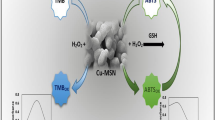Abstract
A novel disposable biosensor based on direct electron transfer of superoxide dismutase (SOD) was fabricated for the determination of superoxide anion. The biosensor was constructed by electrodeposition of gold nanoparticles (GNPs) on the indium tin oxide (ITO) electrode and then immobilization of SOD in silica sol–gel (SG) network in the presence of cysteine on GNPs/ITO modified electrode surface. The distribution of GNPs on ITO electrode surface was examined by scanning electron microscopy (SEM). The immobilized SOD exhibited high catalytical activity towards superoxide anion. Parameters affecting the performance of the biosensor were also investigated. A linear calibration curve was obtained over the range from 0.08 to 0.64 μM with a correlation coefficient of 0.9937. The resulted biosensors were demonstrated to possess striking analytical properties for superoxide anion determination, such as high sensitivity, good accuracy, and long-term stability. It provides a promising platform for the fabrication of disposable biosensors.







Similar content being viewed by others
References
Afonso V, Champy R, Mitrovic D, Collin P (2007) Reactive oxygen species and superoxide dismutases: role in joint diseases. Joint Bone Spine 74:324–329
Auchère F, Rusnak F (2002) What is the ultimate fate of superoxide anion in vivo? J Biol Inorg Chem 7:664–667
Cepinskas G, Rui T, Kvietys PR (2002) Interaction between reactive oxygen metabolites and nitric oxide in oxidant tolerance. Free Radic Biol Med 33:433–440
Halliwell B, Gutteridge JMC (1984) Oxygen toxicity, oxygen radicals, transition metals and disease. Biochem J 219:1–14
Kehrer JP (2000) The Haber–Weiss reaction and mechanisms of toxicity. Toxicology 149:43–50
Seifried HE, Anderson DE, Fisher EI, Milner JA (2007) A review of the interaction among dietary antioxidants and reactive oxygen species. J Nutr Biochem 18:567–579
Ottaviani MF, Spallaci M, Cangiotti M, Bacchiocca M, NinfaliJ P (2001) Electron paramagnetic resonance investigations of free radicals in extra virgin olive oils. Agric Food Chem 49:3691–3696
Diez L, Livertoux M, Stark A, Wellman-Rousseau M, Leroy P (2001) High-performance liquid chromatographic assay of hydroxyl free radical using salicylic acid hydroxylation during in vitro experiments involving thiols. J Chromatogr B Analyt Technol Biomed Life Sci 763:185–193
Tsukagoshi K, Taniguchi T, Nakajima R (2007) Analysis of antioxidants using a capillary electrophoresis with chemiluminescence detection system. Anal Chim Acta 589:66–70
Yao D, Vlessidis AG, Gou Y, Zhou X, Zhou Y, Evmiridis NP (2004) Chemiluminescence detection of superoxide anion release and superoxide dismutase activity: modulation effect of Pulsatilla chinensis. Anal Bioanal Chem 379:171–177
Zhang L, Tang B, Ding Y (2005) Study of 2-(2-pyridyl)benzothiazoline as a novel fluorescent probe for the identification of superoxide anion radicals and the determination of superoxide dismutase activity in scallion genus foods. J Agric Food Chem 53:549–553
Tang B, Wang Y, Ma L (2004) Simple and rapid catalytic spectrophotometric determination of superoxide anion radical and superoxide dismutase activity in natural medical vegetables using phenol as the substrate for horseradish peroxidase. Anal Bioanal Chem 378:523–528
McNeil CJ, Manning P (2002) Sensor-based measurements of the role and interactions of free radicals in cellular systems. Rev Mol Biotechnol 82:443–455
Campanella L, Persi L, Tomassetti M (2000) A new tool for superoxide and nitric oxide radicals determination using suitable enzymatic sensors. Sens Actuators B 68:351–359
Lvovich V, Scheeline A (1997) Amperometric sensors for simultaneous superoxide and hydrogen peroxide detection. Anal Chem 69:454–462
Di J, Bi S, Zhang M (2004) Third-generation superoxide anion sensor based on superoxide dismutase directly immobilized by sol–gel thin film on gold electrode. Biosens Bioelectron 19:1479–1486
Tian Y, Mao L, Okajima T, Ohsaka T (2002) Superoxide dismutase-based third-generation biosensor for superoxide anion. Anal Chem 74:2428–2434
El-Deab MS, Ohsaka T (2007) Direct electron transfer of copper–zinc superoxide dismutase (SOD) on crystallographically oriented Au nanoparticles. Electrochem Commun 9:651–656
Tian Y, Mao L, Okajima T, Ohsaka T (2005) A carbon fiber microelectrode-based third-generation biosensor for superoxide anion. Biosens Bioelectron 21:557–564
Wang L, Mao W, Ni D, Di J, Wu Y, Tu Y (2008) Direct electrodeposition of gold nanoparticles onto indium/tin oxide film coated glass and its application for electrochemical biosensor. Electrochem Commun 10:673–676
Di J, Peng S, Shen C, Gao Y, Tu Y (2007) One-step method embedding superoxide dismutase and gold nanoparticles in silica sol–gel network in the presence of cysteine for construction of third-generation biosensor. Biosens Bioelectron 23:88–94
Dai X, Compton RG (2006) Direct electrodeposition of gold nanoparticles onto indium tin oxide film coated glass: application to the detection of arsenic (III). Anal Sci 22:567–570
Tian Y, Ariga T, Takashima N, Okajima T, Mao L, Ohsaka T (2004) Self-assembled monolayers suitable for electron-transfer promotion of copper, zinc-superoxide dismutase. Electrochem Commun 6:609–614
Choi MF, Hawkins P (1995) The contact charge transfer absorption spectrum of dimethysulphoxide with oxyen. Spectrochim Acta [A] 51:579–585
Lisdat F, Ge B, Ehrentreich-Förster E, Reszka R, Scheller FW (1999) Superoxide dismutase activity measurement using cytochrome c-modified electrode. Anal Chem 71:1359–1365
Beissenhirtz MK, Scheller FW, Viezzoli MS, Lisdat F (2006) Engineered superoxide dismutase monomers for superoxide biosensor applications. Anal Chem 78:928–935
Acknowledgments
This work was supported by the National Natural Science Foundation of China (No. 20675055) and the science foundations of the education bureau of Jiangsu Province (07KJB150101).
Author information
Authors and Affiliations
Corresponding author
Rights and permissions
About this article
Cite this article
Wang, Y., Wu, Y., Wang, J. et al. Disposable superoxide anion biosensor based on superoxide dismutase entrapped in silica sol–gel matrix at gold nanoparticles modified ITO electrode. Bioprocess Biosyst Eng 32, 531–536 (2009). https://doi.org/10.1007/s00449-008-0273-x
Received:
Accepted:
Published:
Issue Date:
DOI: https://doi.org/10.1007/s00449-008-0273-x




